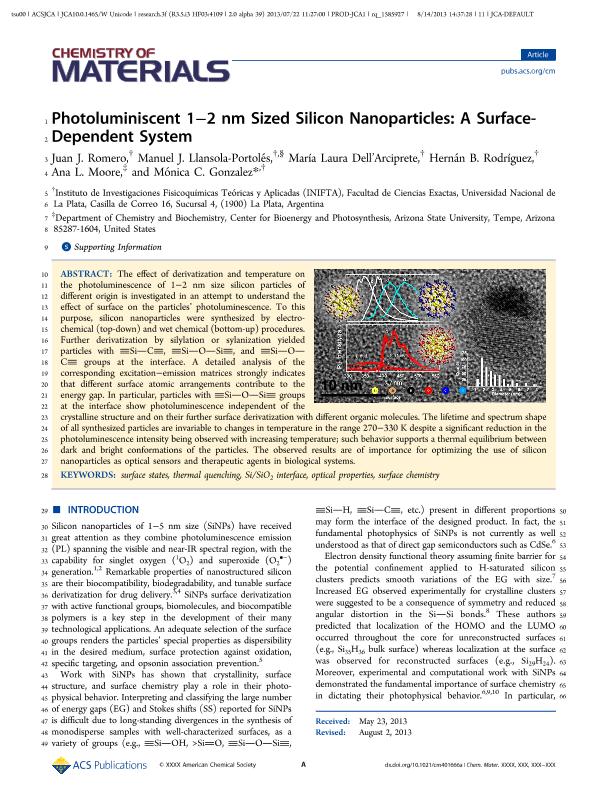Artículo
Photoluminescent 1-2 nm size silicon nanoparticles: A surface-dependent system
Romero, Juan José; Llansola Portolés, Manuel Jose; Dell'Arciprete, Maria Laura ; Rodriguez, Hernan Bernardo
; Rodriguez, Hernan Bernardo ; Moore, Ana L. ; Gonzalez, Monica Cristina
; Moore, Ana L. ; Gonzalez, Monica Cristina
 ; Rodriguez, Hernan Bernardo
; Rodriguez, Hernan Bernardo ; Moore, Ana L. ; Gonzalez, Monica Cristina
; Moore, Ana L. ; Gonzalez, Monica Cristina
Fecha de publicación:
08/2013
Editorial:
American Chemical Society
Revista:
Chemistry Of Materials
ISSN:
0897-4756
Idioma:
Inglés
Tipo de recurso:
Artículo publicado
Clasificación temática:
Resumen
The effect of derivatization and temperature on the photoluminescence of 1–2 nm size silicon particles of different origin is investigated in an attempt to understand the effect of surface on the particles’ photoluminescence. To this purpose, silicon nanoparticles were synthesized by electrochemical (top-down) and wet chemical (bottom-up) procedures. Further derivatization by silylation or sylanization yielded particles with ≡Si—C≡, ≡Si—O—Si≡, and ≡Si—O—C≡ groups at the interface. A detailed analysis of the corresponding excitation–emission matrices strongly indicates that different surface atomic arrangements contribute to the energy gap. In particular, particles with ≡Si—O—Si≡ groups at the interface show photoluminescence independent of the crystalline structure and on their further surface derivatization with different organic molecules. The lifetime and spectrum shape of all synthesized particles are invariable to changes in temperature in the range 270–330 K despite a significant reduction in the photoluminescence intensity being observed with increasing temperature; such behavior supports a thermal equilibrium between dark and bright conformations of the particles. The observed results are of importance for optimizing the use of silicon nanoparticles as optical sensors and therapeutic agents in biological systems.
Archivos asociados
Licencia
Identificadores
Colecciones
Articulos(INIFTA)
Articulos de INST.DE INV.FISICOQUIMICAS TEORICAS Y APLIC.
Articulos de INST.DE INV.FISICOQUIMICAS TEORICAS Y APLIC.
Articulos(SEDE CENTRAL)
Articulos de SEDE CENTRAL
Articulos de SEDE CENTRAL
Citación
Romero, Juan José; Llansola Portolés, Manuel Jose; Dell'Arciprete, Maria Laura; Rodriguez, Hernan Bernardo; Moore, Ana L. ; et al.; Photoluminescent 1-2 nm size silicon nanoparticles: A surface-dependent system; American Chemical Society; Chemistry Of Materials; 25; 17; 8-2013; 3488-3498
Compartir
Altmétricas



